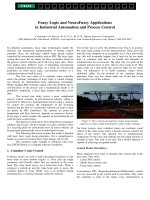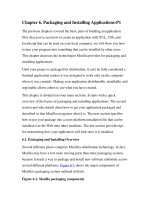LECTURE 6: BINS AND BALLS, APPLICATIONS: HASHING & BLOOM FILTERS ppt
Bạn đang xem bản rút gọn của tài liệu. Xem và tải ngay bản đầy đủ của tài liệu tại đây (253.13 KB, 19 trang )
Probability in Computing
© 2010, Van Nguyen
Probability for Computing 1
LECTURE 6: BINS AND BALLS,
APPLICATIONS: HASHING & BLOOM FILTERS
Agenda
Review: the problem of bins and balls
Poisson distribution
Hashing
© 2010, Van Nguyen
Probability for Computing 2
Hashing
Bloom Filters
Balls into Bins
We have m balls that are thrown into n bins,
with the location of each ball chosen
independently and uniformly at random from n
possibilities.
What does the distribution of the balls into the
bins look like
© 2010, Van Nguyen
Probability for Computing 3
What does the distribution of the balls into the
bins look like
“Birthday paradox” question: is there a bin with at
least 2 balls
How many of the bins are empty?
How many balls are in the fullest bin?
Answers to these questions give solutions to
many problems in the design and analysis of
algorithms
The maximum load
When n balls are thrown independently and uniformly at
random into n bins, the probability that the maximum
load is more than 3 ln
n
/lnln
n
is at most 1/
n
for
n
sufficiently large.
By Union bound, Pr [bin 1 receives M balls]
Note that:
© 2010, Van Nguyen
Probability for Computing 4
Note that:
Now, using Union bound again, Pr [ any ball receives M balls]
is at most
which is
1/n
Application: Bucket Sort
A sorting algorithm that
breaks the (nlogn) lower
bound under certain input
assumption
Bucket sort works as follows:
© 2010, Van Nguyen
Probability for Computing 5
Bucket sort works as follows:
Set up an array of initially
empty "buckets."
Scatter: Go over the original
array, putting each object in its
bucket.
Sort each non-empty bucket.
Gather: Visit the buckets in
order and put all elements back
into the original array.
A set of n =2
m
integers,
randomly chosen from
[0,2
k
),km, can be sorted
in expected time O(n)
Why: will analyze later!
The Poisson Distribution
Consider m balls, n bins
Pr [ a given bin is empty] =
Let X
j
is a indicator r.v. that is 1 if bin j empty, 0 otherwise
Let X be a r.v. that represents # empty bins
© 2010, Van Nguyen
Probability for Computing 6
Generalizing this argument, Pr [a given bin has r balls] =
Approximately,
So:
Limit of the Binomial Distribution
© 2010, Van Nguyen
Probability for Computing 7
Application: Hashing
The balls-and-bins model is good to model hashing
Example: password checker
Goal: prevent people from choosing common, easily cracked
passwords
Keeping a dictionary of unacceptable passwords and check newly
created password against this dictionary.
© 2010, Van Nguyen
Probability for Computing 8
created password against this dictionary.
Initial approach: Sorting this dictionary and do binary
search on it when checking a password
Would require (log m) time for m words in the dictionary
New approach: chain hashing
Place the words into bins and search appropriate bin for the word
The worlds in a bin: implemented as a linked list
The placement of words into bins is done by using a hash function
Chain hashing
Hash table
A hash function f: U [0,n-1] is a way of placing items from the
universe U into n bins
Here, U consists of all possible password strings
The collection of bins called hash table
Chain hashing: items that fall into the same bin are chained
© 2010, Van Nguyen
Probability for Computing 9
Chain hashing: items that fall into the same bin are chained
together in a linked list
Using a hash table turns the dictionary problem into a
balls-and-bins problem
m words, hashing range [0 n-1] m balls, n bins
Making assumption: we can design perfect hash functions that map
words into bins uniformly random
A given word could be mapped into any bin with the same probability
Search time in chain hashing
To search for an item
First hash it to find the corresponding bin then find
it in the bin: sequential search through the linked
list
The expected # balls in a bin is about m/n
expected time for the search is
(m/n)
© 2010, Van Nguyen
Probability for Computing 10
expected time for the search is
(m/n)
If we chose m=n then a search takes expectedly
constant time
Worst case
maximum # balls in a bin: (
ln
n
/
lnln
n
) if choose m=n
Another disadvantage: wasting a lot of space in
empty bins
Hashing: bit strings
In chain hashing, n balls n bins, we waste a lot of
empty bins should have m/n >>1
Hashing using sort fingerprints will help
Suppose: passwords are 8-char, i.e. 64 bits
We use a hash function that maps each pwd into a 32
-
bit
© 2010, Van Nguyen
Probability for Computing 11
We use a hash function that maps each pwd into a 32
-
bit
string, i.e. a fingerprint
We store the dictionary of fingerprints of the unacceptable
passwords
When checking a password, compute its fingerprint then
check it against the dictionary: if found then reject this
password
But it is possible that our password checker may not
give the correct answer!
False positives
This hashing scheme gives a false positive
when it rejects a good password
The fingerprint of this password accidentally
matches that of an unacceptable password
© 2010, Van Nguyen
Probability for Computing 12
matches that of an unacceptable password
For our password checker application this over-
conservative approach is, however, acceptable if
the probability of making a false positive is not
too high
False positive probability
How many bits should we use to create
fingerprints?
We want reasonably small probability of a false
positive match
Prob [the fingerprint of a given good pwd
any given
unacceptable fingerprint] = 1
-
1
/
; here b # bits
© 2010, Van Nguyen
Probability for Computing 13
unacceptable fingerprint] = 1
-
1
/
2
b
; here b # bits
Thus for m unacceptable pwd, prob [false positive
occurs on a given good pwd] = 1- (1-
1
/
2
b
)
m
1- e
-m/2
b
Easy to see that: to make this prob less than a given
small constant, we need b= (log
n
)
If use b=2log
n
bits Prob [ a false positive]= 1-(1-
1
/
m
2
)
m
<
1
/
m
Dictionary of 2
16
words using 32-bit fingerprint false prob
1
/
65,536
An approximate set membership
problem
Suppose we have a set S = {s
1
, s
2
, s
3
, …,
s
m
} of m elements from a large universe set
U. We would like to represent the elements of
S in such a way so that
We can quickly answer the queries of form “Is x is
© 2010, Van Nguyen
Probability for Computing 14
We can quickly answer the queries of form “Is x is
an element of S?”
We want the representation take as little space as
possible
For saving space we can accept occasional
mistakes in form of false positives
E.g. in our password checker application
Bloom filters
A Bloom filter: a data structure for this
approximate set membership problem
By generalizing these mentioned hashing ideas to
achieve more interesting trade-off between
required space and the false positive probability
© 2010, Van Nguyen
Probability for Computing 15
required space and the false positive probability
Consists of an array of
n
bits, A[0] to A[n-1],
initially set to 0
Uses
k
independent hash functions h
1
, h
2
, …, h
k
with range {0,…n-1}; all these are uniformly
random
Represent an element sS by setting A[h
i
(s)] to 1,
i=1, k
Checking: For any
value x, to see if x
S
simply check if
A[h
i
(x)] =1 for all
i=1, k
© 2010, Van Nguyen
Probability for Computing 16
i=1, k
If not, clearly x is not a
member of S
If right, we assume
that x is in S but we
could be wrong!
false positive
False positive probability
The probability of a false positive for an element not in
the set
After all m elements of S are hashed into Bloom filter, Prob[a
give bit =0] = (1-
1
/
n
)
km
e
–km/n
. Let p= e
–km/n
.
Prob [a false positive] = (1- (1-
1
/
n
)
km
)
k
(1-e
–km/n
)
k
= (1-p)
k
.
Let f= (1-p)
k
.
Given m, n what is the optimum k to minimize f?
© 2010, Van Nguyen
Probability for Computing 17
Given m, n what is the optimum k to minimize f?
Note that a higher k gives us more chance to find a 0-bit for an
element not in S, but using fewer h-functions increases the fraction
of 0-bit in the array.
Optimal k = ln2.
n
/
m
which reaches minimum f = ½
k
(0.6185)
n/m
Thus Bloom filters allow a small probability of a false positive
while keep the number of storage bit per item a constant
Note in previous consideration of fingerprints we need (log
m
) bits
per items
Bloom filters: applications
Discovering DoS attack attempt
Computing the difference between SYN
and FIN packets
© 2010, Van Nguyen
Probability for Computing 18
Matching between SYN and FIN packets by 4-
tuples of addresses (source and destination ports)
Many, many other applications
Application of hashing: breaking
symmetry
Suppose that n users want a unique resource
(processes demand CPU time) how can we decide a
permutation quickly and fairly?
Hashing the User ID into 2
b
bits then sort the resulting numbers
That is, smallest hash will go first
How to avoid two users being hashed to the same value?
© 2010, Van Nguyen
Probability for Computing 19
How to avoid two users being hashed to the same value?
If b large enough we can avoid such collisions as in
birthday paradox analysis
Fix an user. Prob [another user has the same hash] = 1- (1-
1
/
2
b
)
n-1
(n-1)
/
2
b
By union bound, prob [two users have the same hash] =
(n-1)n
/
2
b
Thus, choosing b =3log
n
guarantees success with probability 1-
1
/n
Leader election









